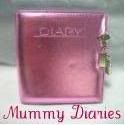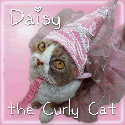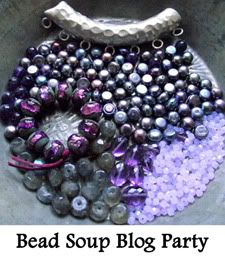It was then that I saw what Erik was drawing and also the possibilities. I am such an opportunist. If it doesn't work one way, I try doing it some other way. I asked Erik, very quietly and politely, if he would mind very much if I took some pictures of his drawings.
------

Some of them look a little like sea-glass! Wonder what Tara Beaulieu of Scarborough Seashells would say about this!
Let's compare the viking beaded glass necklace with one of my beaded glass bracelets from my Etsy shop parltradet:

Apart from two or three representations of (ritual) helmets – with protrusions that may be either stylized ravens, snakes or horns – no depiction of Viking Age warriors' helmets, and no preserved helmet, has horns. In fact, the formal close-quarters style of Viking combat (either in shield walls or aboard "ship islands") would have made horned helmets cumbersome and hazardous to the warrior's own side.
Therefore historians believe that Viking warriors did not use horned helmets, but whether or not such helmets were used in Scandinavian culture for other, ritual purposes remains unproven. The general misconception that Viking warriors wore horned helmets was partly promulgated by the 19th century enthusiasts of Götiska Förbundet, founded in 1811 in Stockholm, Sweden. They promoted the use of Norse mythology as the subject of high art and other ethnological and moral aims.
The Vikings were often depicted with winged helmets and in other clothing taken from Classical antiquity, especially in depictions of Norse gods. This was done in order to legitimize the Vikings and their mythology by associating it with the Classical world which had long been idealized in European culture.
The latter-day mythos created by national romantic ideas blended the Viking Age with aspects of the Nordic Bronze Age some 2,000 years earlier. Horned helmets from the Bronze Age were shown in petroglyphs and appeared in archaeological finds (see Bohuslän and Vikso helmets). They were probably used for ceremonial purposes.[41].
Cartoons like Hägar the Horrible and Vicky the Viking, and sports uniforms such as those of the Minnesota Vikings and Canberra Raiders football teams have perpetuated the mythic cliché of the horned helmet.
Viking helmets were conical, made from hard leather with wood and metallic reinforcement for regular troops. The iron helmet with mask and chain mail was for the chieftains, based on the previous Vendel-age helmets from central Sweden. The only true Viking helmet found is that from Gjermundbu in Norway. This helmet is made of iron and has been dated to the 10th century.
------
Who exactly were the Vikings? (Wikkipedia helps us out here.)
In the modern Scandinavian languages, the word viking usually refers specifically to those people who went on Viking expeditions.[5]
The word Viking was introduced into Modern English during the 18th-century "Viking revival", at which point it acquired romanticized heroic overtones of "barbarian warrior" or noble savage. During the 20th century, the meaning of the term was expanded to refer not only to seaborne raiders from Scandinavia, but secondarily to any Scandinavian who lived during the period from the late eighth to the mid-eleventh centuries, or more loosely from c. 700 to as late as about 1100. As an adjective, the word is used to refer to ideas, phenomena or artifacts connected with Scandinavians and their cultural life in these centuries, producing expressions like "Viking age", "Viking culture", "Viking art", "Viking religion", "Viking ship", and so on. The people of medieval Scandinavia are also referred to as Norse, although this term properly applies only to the Old-Norse-speaking peoples of Scandinavia, and not to the Sami.
The term Varangians made its first appearance in Byzantium where it was introduced to designate a function. In Russia it was extended to apply to Scandinavian warriors journeying to and from Constantinople. In the Byzantine sources Varangians are first mentioned in 1034 as in garrison in the Thracian theme. The Persian geographer Al Biruni has mentioned the Baltic Sea as the Varangian Sea and specifies the Varangians as a people dwelling on its coasts. The first datable use of the word in Norse literature appears by Einarr Skúlason in 1153. According to Icelandic Njalssaga from the 13th century, the institution of Varangian Guard was established by 1000. In the Russian Primary Chronicle, the Varangian is used as a generic term for the Germanic nations on the coasts of the Baltic sea that likewise lived in the west as far as the land of the English and the French.[6]
------
The Internet is a great tool. Sometimes, you can make discoveries! Look at this chain here that belongs to the Museum of Antiquities in Stockholm. I am reading the text about it and suddenly I see a name that is familar to me. This chain was found by a farmer while plowing his fields in 1882. He handed it over to a veterinarian who was also a collector of artifacts and who then gave it to the museum. The vet was my great-grandfather, Fredrik A. Nordeman!
And I just saw this now, Saturday, June 19th, 2010!
Happy Weekend!
Anna
------

Tuesday, June 15th - Dogs Deserve Freedom

Wednesday, June 16th - Lenox Knits

Saturday June 19th - Split Rock Ranch

Sunday, June 20th - Sara Cat writes /Sara Katt skriver

Best wishes,


























































6 Comments:
Anna thank you for the look at the Vikings. I love the drawing. As a boy we use to watch a lot of Viking movies. I believe all boys like the excitement of the Viking Tales.
Wow...now I have my answer about the helmets! very cool!
About the paper soliders - My children and I were dirt poor when they were little, therefore,I could not afford many toys. Would you believe that my son would draw toys and play with them, like your son? I'll tell you what...it makes they appreciate what they have now and also taught my son to think outside the box!
About my brother's tattoo...there are letters in it that don't appear in the book. I will have to draw what I see in the picture and post it so you can try to deciper it. However, it is in a circle pattern on his shoulder and some of the letters don't show up in the picture. Let me work on this during the week...I'm dying to know what it means!
Thank you for hosting my Entrecard ad today! So sorry I haven't been visiting much lately but things are so insanely crazy busy around here I feel like a dog chasing my own tail! Hugs to you from Sunny Colorado USA!
Wowza...what a great [seriously thorough and fascinating] answer Anna! Right before I got to that part of your post, it occurred to me that maybe it was Helga of Hagar the Horrible that made the horns fashionable *Grin*. Thanks for a terrific followup post (and the link love too! :o)
I hate when the kids want things and I cannot give it to them, but I guess that is life. I enjoyed your viking feature here! I hope you are doing well--I'll have to catch up with you through email one of these days. Life has been busy!
That was awesome of you to look that info up! Thanks for sharing! I love the jewelry! Annw
Post a Comment